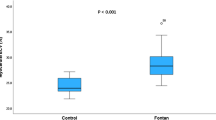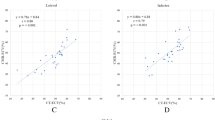Abstract
Objective
Positron emission tomography (PET) integrating assessment of perfusion with 13N-ammonia (NH3) and viability with 18F-fluorodeoxyglucose (FDG) has high accuracy to identify viable, hibernating myocardium. We tested whether quantification of myocardial blood flow (MBF) and washout (k2) can predict myocardial viability using FDG as standard of reference.
Methods
In 180 consecutive patients with ischemic cardiomyopathy, myocardium was categorized on a segment-level into normal, ischemic, hibernating, and scar. From dynamic images, stress MBF, rest MBF, and k2 were derived and myocardial flow reserve (MFR) and volume of distribution (VD) were calculated.
Results
Across myocardial tissues, all parameters differed significantly. The area under the curve (AUC) was 0.564 (95% CI 0.527-0.601), 0.635 (0.599-0.671), 0.553 (0.516-0.591), 0.520 (0.482-0.559), and 0.560 (0.522-0.597) for stress MBF, rest MBF, MFR, k2, and VD. The generalized linear mixed model correctly classified 81% of scar as viable, hibernating myocardium. If the threshold of rest MBF to predict viability was set to 0.45 mL·min−1·g−1, sensitivity and specificity were 96% and 12%, respectively.
Conclusion
Quantitative NH3 PET parameters have low to moderate diagnostic performance to predict viability in ischemic cardiomyopathy. However, if rest MBF falls below 0.45 mL·min−1·g−1, viability testing by FDG-PET may be safely deferred.




Similar content being viewed by others
Abbreviations
- PET:
-
Positron emission tomography
- NH3:
-
13N-ammonia
- FDG:
-
18F-fluorodeoxyglucose
- MBF:
-
Myocardial blood flow
- MFR:
-
Myocardial flow reserve
- VD:
-
Volume of distribution
- LVEF:
-
Left ventricular ejection fraction
- CAD:
-
Coronary artery disease
- ROC:
-
Receiver-operating characteristics
References
Jessup M, Brozena S. Heart failure. N Engl J Med 2003;348:2007-18.
Tillisch J, Brunken R, Marshall R, Schwaiger M, Mandelkern M, Phelps M, et al. Reversibility of cardiac wall-motion abnormalities predicted by positron tomography. N Engl J Med 1986;314:884-8.
Velazquez EJ, Lee KL, Jones RH, Al-Khalidi HR, Hill JA, Panza JA, et al. Coronary-artery bypass surgery in patients with ischemic cardiomyopathy. N Engl J Med 2016;374:1511-20.
Lim SP, Mc Ardle BA, Beanlands RS, Hessian RC. Myocardial viability: it is still alive. Semin Nucl Med 2014;44:358-74.
Bax JJ, Maddahi J, Poldermans D, Elhendy A, Schinkel A, Boersma E, et al. Preoperative comparison of different noninvasive strategies for predicting improvement in left ventricular function after coronary artery bypass grafting. Am J Cardiol 2003;92:1-4.
Gould KL, Lipscomb K, Hamilton GW. Physiologic basis for assessing critical coronary stenosis. Instantaneous flow response and regional distribution during coronary hyperemia as measures of coronary flow reserve. Am J Cardiol 1974;33:87-94.
Johnson NP, Gould KL. Integrating noninvasive absolute flow, coronary flow reserve, and ischemic thresholds into a comprehensive map of physiological severity. JACC Cardiovasc Imaging 2012;5:430-40.
Herzog BA, Husmann L, Valenta I, Gaemperli O, Siegrist PT, Tay FM, et al. Long-term prognostic value of 13 N-ammonia myocardial perfusion positron emission tomography added value of coronary flow reserve. J Am Coll Cardiol 2009;54:150-6.
Gupta A, Taqueti VR, van de Hoef TP, Bajaj NS, Bravo PE, Murthy VL, et al. Integrated noninvasive physiological assessment of coronary circulatory function and impact on cardiovascular mortality in patients with stable coronary artery disease. Circulation 2017;136:2325-36.
Rauch B, Helus F, Grunze M, Braunwell E, Mall G, Hasselbach W, et al. Kinetics of 13 N-ammonia uptake in myocardial single cells indicating potential limitations in its applicability as a marker of myocardial blood flow. Circulation 1985;71:387-93.
Beanlands RS, deKemp R, Scheffel A, Nahmias C, Garnett ES, Coates G, et al. Can nitrogen-13 ammonia kinetic modeling define myocardial viability independent of fluorine-18 fluorodeoxyglucose? J Am Coll Cardiol 1997;29:537-43.
Gewirtz H, Fischman AJ, Abraham S, Gilson M, Strauss HW, Alpert NM. Positron emission tomographic measurements of absolute regional myocardial blood flow permits identification of nonviable myocardium in patients with chronic myocardial infarction. J Am Coll Cardiol 1994;23:851-9.
Benz DC, Gräni C, Ferro P, Neumeier L, Messerli M, Possner M, et al. Corrected coronary opacification decrease from coronary computed tomography angiography: Validation with quantitative 13 N-ammonia positron emission tomography. J Nucl Cardiol 2017. https://doi.org/10.1007/s12350-017-0980-2.
Nkoulou R, Pazhenkottil AP, Buechel RR, Husmann L, Valenta I, Herzog BA, et al. Impact of CT attenuation correction on the viability pattern assessed by 99mTc-tetrofosmin SPECT/18F-FDG PET. Int J Cardiovasc Imaging 2011;27:913-21.
Verberne HJ, Acampa W, Anagnostopoulos C, Ballinger J, Bengel F, De Bondt P, et al. EANM procedural guidelines for radionuclide myocardial perfusion imaging with SPECT and SPECT/CT: 2015 revision. Eur J Nucl Med Mol Imaging 2015;42:1929-40.
Ling LF, Marwick TH, Flores DR, Jaber WA, Brunken RC, Cerqueira MD, et al. Identification of therapeutic benefit from revascularization in patients with left ventricular systolic dysfunction: inducible ischemia versus hibernating myocardium. Circ Cardiovasc Imaging 2013;6:363-72.
Siegrist PT, Gaemperli O, Koepfli P, Schepis T, Namdar M, Valenta I, et al. Repeatability of cold pressor test-induced flow increase assessed with H(2)(15)O and PET. J Nucl Med 2006;47:1420-6.
Schindler TH, Schelbert HR, Quercioli A, Dilsizian V. Cardiac PET imaging for the detection and monitoring of coronary artery disease and microvascular health. JACC Cardiovasc Imaging 2010;3:623-40.
vom Dahl J, Muzik O, Wolfe ER Jr, Allman C, Hutchins G, Schwaiger M. Myocardial rubidium-82 tissue kinetics assessed by dynamic positron emission tomography as a marker of myocardial cell membrane integrity and viability. Circulation 1996;93:238-45.
Gould KL, Yoshida K, Hess MJ, Haynie M, Mullani N, Smalling RW. Myocardial metabolism of fluorodeoxyglucose compared to cell membrane integrity for the potassium analogue rubidium-82 for assessing infarct size in man by PET. J Nucl Med 1991;32:1-9.
Chien DT, Bravo P, Higuchi T, Merrill J, Bengel FM. Washout of (8)(2)Rb as a marker of impaired tissue integrity, obtained by list-mode cardiac PET/CT: Relationship with perfusion/metabolism patterns of myocardial viability. Eur J Nucl Med Mol Imaging 2011;38:1507-15.
Stankewicz MA, Mansour CS, Eisner RL, Churchwell KB, Williams BR, Sigman SR, et al. Myocardial viability assessment by PET: (82)Rb defect washout does not predict the results of metabolic-perfusion mismatch. J Nucl Med 2005;46:1602-9.
Moody J, Hiller K, Lee B, Poitrasson-Rivière A, Corbett J, Weinberg R, et al. The utility of 82Rb PET for myocardial viability assessment: comparison with perfusion-metabolism 82Rb-18F-FDG PET. J Nucl Cardiol 2019. https://doi.org/10.1007/s12350-019-01615-0.
Kitsiou AN, Bacharach SL, Bartlett ML, Srinivasan G, Summers RM, Quyyumi AA, et al. 13 N-ammonia myocardial blood flow and uptake: relation to functional outcome of asynergic regions after revascularization. J Am Coll Cardiol 1999;33:678-86.
Beanlands RS, Nichol G, Huszti E, Humen D, Racine N, Freeman M, et al. F-18-fluorodeoxyglucose positron emission tomography imaging-assisted management of patients with severe left ventricular dysfunction and suspected coronary disease: a randomized, controlled trial (PARR-2). J Am Coll Cardiol 2007;50:2002-12.
Bonow RO, Maurer G, Lee KL, Holly TA, Binkley PF, Desvigne-Nickens P, et al. Myocardial viability and survival in ischemic left ventricular dysfunction. N Engl J Med 2011;364:1617-25.
D’Egidio G, Nichol G, Williams KA, Guo A, Garrard L, deKemp R, et al. Increasing benefit from revascularization is associated with increasing amounts of myocardial hibernation: A substudy of the PARR-2 trial. JACC Cardiovasc Imaging 2009;2:1060-8.
Allman KC, Shaw LJ, Hachamovitch R, Udelson JE. Myocardial viability testing and impact of revascularization on prognosis in patients with coronary artery disease and left ventricular dysfunction: A meta-analysis. J Am Coll Cardiol 2002;39:1151-8.
Geske JB, Gersh BJ. Angina in revascularization of ischemic cardiomyopathy: The whole quilt, or just a STICH? J Am Coll Cardiol 2015;66:2101-3.
Beanlands RS, Ruddy TD, deKemp RA, Iwanochko RM, Coates G, Freeman M, et al. Positron emission tomography and recovery following revascularization (PARR-1): The importance of scar and the development of a prediction rule for the degree of recovery of left ventricular function. J Am Coll Cardiol 2002;40:1735-43.
Hachamovitch R, Hayes SW, Friedman JD, Cohen I, Berman DS. Comparison of the short-term survival benefit associated with revascularization compared with medical therapy in patients with no prior coronary artery disease undergoing stress myocardial perfusion single photon emission computed tomography. Circulation 2003;107:2900-7.
Panza JA, Holly TA, Asch FM, She L, Pellikka PA, Velazquez EJ, et al. Inducible myocardial ischemia and outcomes in patients with coronary artery disease and left ventricular dysfunction. J Am Coll Cardiol 2013;61:1860-70.
Narula J, Dawson MS, Singh BK, Amanullah A, Acio ER, Chaudhry FA, et al. Noninvasive characterization of stunned, hibernating, remodeled and nonviable myocardium in ischemic cardiomyopathy. J Am Coll Cardiol 2000;36:1913-9.
Murthy VL, Naya M, Foster CR, Hainer J, Gaber M, Di Carli G, et al. Improved cardiac risk assessment with noninvasive measures of coronary flow reserve. Circulation 2011;124:2215-24.
Lee JM, Kim CH, Koo BK, Hwang D, Park J, Zhang J, et al. Integrated myocardial perfusion imaging diagnostics improve detection of functionally significant coronary artery stenosis by 13 N-ammonia positron emission tomography. Circ Cardiovasc Imaging 2016. https://doi.org/10.1161/CIRCIMAGING.116.004768.
Johnson NP, Gould KL, Di Carli MF, Taqueti VR. Invasive FFR and noninvasive CFR in the evaluation of ischemia: What is the future? J Am Coll Cardiol 2016;67:2772-88.
Taqueti VR, Hachamovitch R, Murthy VL, Naya M, Foster CR, Hainer J, et al. Global coronary flow reserve is associated with adverse cardiovascular events independently of luminal angiographic severity and modifies the effect of early revascularization. Circulation 2015;131:19-27.
Acknowledgements
We thank Verena Weichselbaumer, Martina Vogt, Tania Lagrange, Kevin Frei, Kathrin Amsler, Frederic Koszarski und Bejtulah Salahi for their excellent technical support.
Disclosure
The University Hospital Zurich holds a research agreement with GE Healthcare. Dr. Dominik C. Benz reports a research Grant from the Theodor and Ida Herzog-Egli Foundation. Paola Ferro, Nico Safa, Michael Messerli, Elia von Felten, Wenjie Huang, Dimitri Patriki, Andreas A. Giannopoulos, Tobias A. Fuchs, Christoph Gräni, Catherine Gebhard, Aju P. Pazhenkottil, Philipp A. Kaufmann, and Ronny R. Buechel have nothing to disclose.
Author information
Authors and Affiliations
Corresponding author
Additional information
Publisher's Note
Springer Nature remains neutral with regard to jurisdictional claims in published maps and institutional affiliations.
The authors of this article have provided a PowerPoint file, available for download at SpringerLink, which summarises the contents of the paper and is free for re-use at meetings and presentations. Search for the article DOI on SpringerLink.com
Electronic supplementary material
Below is the link to the electronic supplementary material.
Rights and permissions
About this article
Cite this article
Benz, D.C., Ferro, P., Safa, N. et al. Role of quantitative myocardial blood flow and 13N-ammonia washout for viability assessment in ischemic cardiomyopathy. J. Nucl. Cardiol. 28, 263–273 (2021). https://doi.org/10.1007/s12350-019-01684-1
Received:
Accepted:
Published:
Issue Date:
DOI: https://doi.org/10.1007/s12350-019-01684-1




